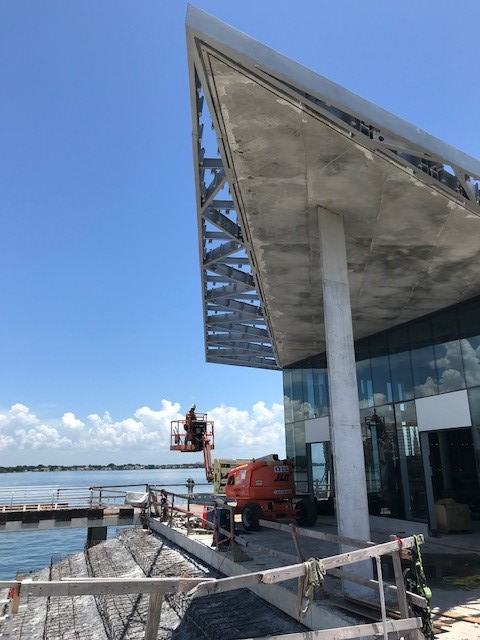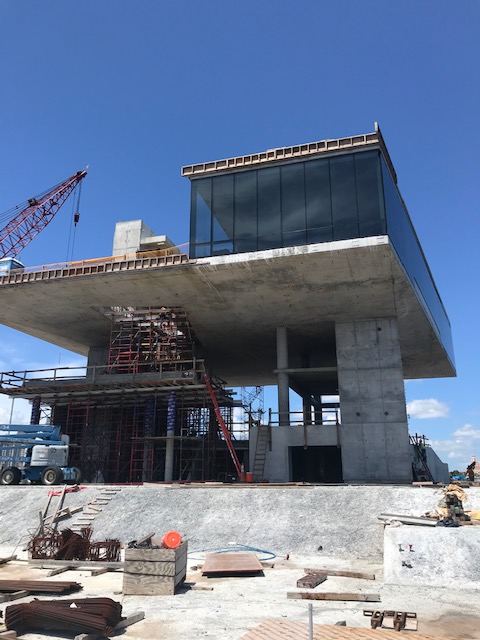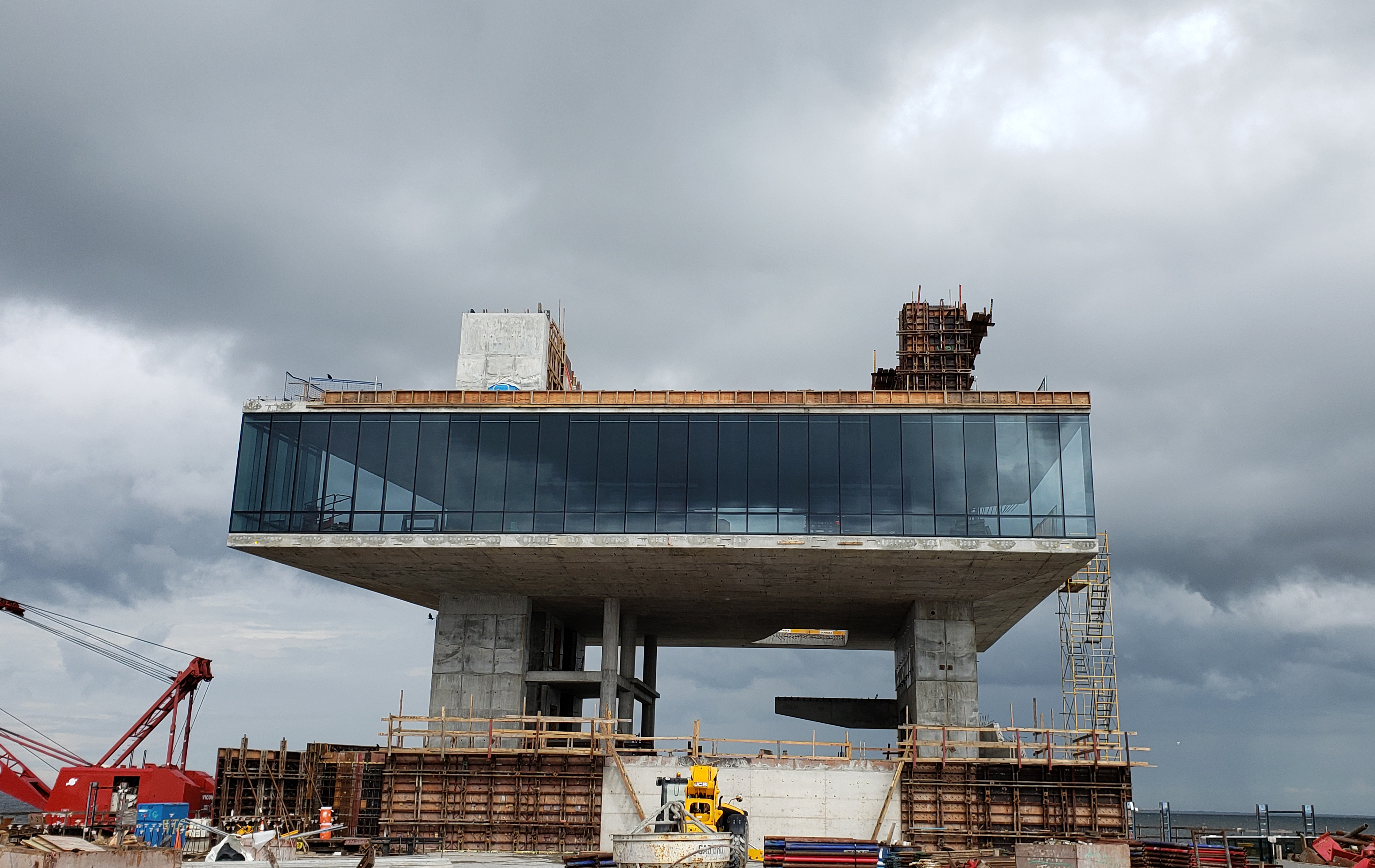in collaboration with Joe Stewart, SE
St. Petersburg Pier has a long history in the City of Tampa Bay, and this new project is the next phase for this storied development. The Pier was built as a part of the original Orange Belt Railway in 1889, and was the first pier in Tampa Bay allowing for the delivery of goods to the city. In an effort to modernize and revitalize the area, the City and then mayor, Rick Kriseman, conceived of an ambitious project to build a new pier and resultant amenities. The new pier will include three exciting and attractive buildings meant to engage the public through an Education Center, a Pavilion Building and the Pier Head Building.
Throughout the years, the pier had survived several remodels, expansions and modifications. In a 2004 report addressed to the City Council, a team of consultants concluded that the structural maintenance program in place for the Pier approach and head were no longer cost effective. and the report urged the City Council to consider a complete replacement of the structure. The new development will incorporate three main buildings:
- The Education Center Building
- The Pavilion Building
- Pier Head Building
All of these buildings are concrete structures with shear walls, post-tensioned slabs and columns. Construction of this transformative project started in 2017, and is nearing completion, at end of this year. KPFF became involved in the project after construction was underway. KPFF became involved as part of the subcontractor team with MG McGrath, a valued partner of ours. Together we designed the exterior steel canopies and metal cladding components for all three buildings. Our relationship started in 2016 when we worked together on the design and construction of “the Horn” Medtronic Monument, located at the Minnesota Vikings Stadium. The relationship continues to strengthen on this project thanks to our teamwork on this fast-paced schedule. The design of the canopies had to be done while the building was under construction, and early procurement of connections played a large role in the adjustments to the concrete pour schedules.

The canopies for the Education and Pavilion Buildings are connected to the main post tensioned slab only at the edges, cantilevering between 5-10’ for the Education Center and 10-16’ for the Pavilion Building. The first challenge that we faced was to design a connection that allowed the pouring of the post-tensioned slab without interfering with the tendons, the post-tensioning process, and the installation of hardware for the connections. All of the concrete is exposed, therefore visible connections were not an acceptable option.
Our team proposed the use of cast-in-place form savers to accomplish the desired connection and allow the construction process to proceed without disruption. This also allowed the design team to continue the development of the steel framing options while the embeds were installed on site. The connection to the form savers was accomplished by high-strength galvanized bolts which saved time during the erection of the steel on site.

The steel design included a value engineering option to minimize the lead time by using standard steel sections in lieu of customized steel plates. We collaborated closely with the architect of record to select the appropriate steel section in width and depth to meet the design intent. Standard steel channels were the preferred option as they provided the required width and depth. Also, standard steel channel sections could be procured quickly, minimizing the steel lead time.
Another aspect of the design of the canopies is the interaction with the aluminum frame to support the perforated aluminum panels. Getting the design right required coordination between our team, the steel fabricator and the MG McGrath team to create a frame and supports that were modular in nature. This sped up the construction process by maximizing offsite fabrication and minimizing the installation time on site. Our design included the use of mortise and tenon connections between the perimeter aluminum frame and the stiffening interior frames that support the perforated metal panels. This connection design accelerated the construction of the frames in the shop and provided clean exposed joinery for the underside of the panels.
The Pierhead Building, a six-story concrete structure, is the jewel that crowns this masterpiece of a development. Our contribution included the design of the fourth-floor aluminum panels soffits and the steel canopy at the top. The structure, like the other buildings, is comprised of concrete walls and post-tensioned slabs. The main canopy has a cantilevered span of 37’ and a section that connects the top level to the fourth level also known as “The Tail.”
The steel sections are 36” deep and a maximum of 6” wide for the flanges. Several options of standard sections were considered, but the most optimal section for this canopy was a built-up I-type girder that matched the architectural width requirements and provided a clean edge for the exposed steel members. The connection of the steel beams to the concrete walls was done with Williams all-threaded reinforcing bars connecting the beam seats that are connected to the steel beams. This canopy is currently under fabrication and the first pieces of steel have been shipped to the site to begin the erection process.

The Pierhead soffit aluminum structure is hanging from the fourth-level slab and is comprised of aluminum triangles supporting the aluminum perforated metal panels. The soffit has over two hundred and twenty-four connections only to the underside of the slab. The main challenge with these connections was to allow the needed movement during construction to accommodate the slab slopes, the narrow heights between the slab and the soffit, and the potential misalignment of the embeds. Our team, in close coordination with MG McGrath team, developed a concept with hanger rods, couplers and aluminum plates that provided the required flexibility for field installation. The soffit is currently under production and the installation of the panels will begin in the upcoming weeks.
Our dedicated team has put significant effort into this project, and every engineer has been exposed to concrete, steel and aluminum design. As is our custom, the process has been highly collaborative, and we have enjoyed working with the architect, fabricators, and the contractor to develop unique solutions to streamline the fabrication and erection process. We are proud to be part of MG McGrath team and this impactful project for the City of Tampa Bay.


